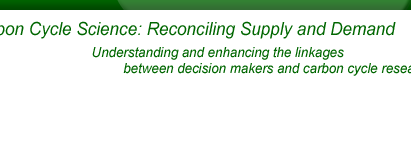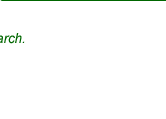 |
|
|
|
 |
|||||
|
|
|
|
|||||||
 |
|
|
|
|
|||||
 |
|||||||||
 |
|
|
|
|
Carbon Cycle Science Demand Side Actors
Demand side actors represent a wide array of interests, organizations, government agencies and ngos. Most share a common interest, however, in their desire to use C cycle science in future policy decisions and outcomes. One way in which we can understand the user’s need for C cycle science information is to place their needs in the context of how they might use the C cycle information in future decision making processes. For example, will the demand side actor use the information to promote a ‘public awareness campaign’ that encourages the passage of legislation? Or, will the information be used as a means to account for, and enforce, international carbon sequestration agreements?
Harold Lasswell describes the decision process as comprising a “sequence of seven phases”, which include the phases of intelligence, promotion, prescription, invocation, application, termination and appraisal (1971, p 28). We will utilize these decision phases in order to ‘map’ how and when the demand side actors use the scientific information in order to make decisions and generate outcomes. In so doing we will be able to identify some of the linkages and gaps in the supply and demand of C cycle information. What follows is a summary of some of the actors involved, and is not intended to be an all inclusive list. Also, some organizations listed below use C cycle information in more than one decision phase, such as in intelligence and promotion, but for purposes of simplicity, we have placed them in just one category. (For more information about these companies, please go to ‘Carbon Cycle Science Demand – Links’).
Intelligence
The Intelligence Phase describes the process of gathering, processing and disseminating information that is used by decision makers. Demand side actors use the information during this phase in order to explore the feasibility of potential sequestration projects, identify possible policy alternatives and to enhance their general understanding of C cycle science. One of the largest sectors that demands C cycle science – and one of the largest suppliers of that information – is the United States Government. Demand side actors include:
- The Department of Energy: FutureGen, the largest sequestration project undertaken in North America.
- DOE Office of Fossil Energy: Seven Nationwide Regional Partnership program that brings together a wide array of actors to identify C sequestration opportunities.
- The Energy Information Administration: Utilizes the science to highlight land use and forestry issues related to atmospheric greenhouse gases and also provides technical assistance for organizations who wish to calculate their CO2 emissions.
- The United States Department of Agriculture’s Action Plan (Component I): Identifies what C cycle and sequestration science is needed by discussing what is known, and what is unknown in each of the eight subject areas it covers.
- USDA’s Soils and the Global C Cycle: goals of the program include studying the dynamics of soil organic and inorganic C pools and fluxes for principal ecoregions, and to assess the impact of anthropogenic activities on these pools and fluxes. Information is also used to enhance public awareness about using the soil to sequester carbon.
- United States Environmental Protection Agency: Uses C cycle science information for public outreach and education.
- United States Agency for International Development: publishes Global Climate Change Reports.
- California Inventory of California Greenhouse Gas Emissions and Sinks: 1990-1999.
- Pew Center on Global Climate Change: State and Local Net Greenhouse Gas Emissions Reduction Programs.
- The EPA’s State and Local Greenhouse Gas Mitigation Case Studies highlights actions taken by state and local agencies.
- Climate Ark: an educational global climate change and renewable energy portal.
- American Forests: uses information to calculate the carbon stored in forests and carbon mitigation that is possible by planting trees in urban areas.
- Trexler and Associates, Inc.: consults on climate change mitigation and C cycle sequestration.
Promotion
The Promotion Phase involves a process of advocating for a specific policy alternative by generating support from decision makers for that particular policy choice. In short, this phase is about promoting one policy alternative over another.
- Union of Concerned Scientists: works both to inform citizens and to advocate for ‘practical environmental solutions’.
- American Electric Power: the largest electric power producer in the United States prefers voluntary activities to reduce GHG emissions rather than mandatory requirements. Active in voluntary sequestration projects.
- Noel Kempff Mercado Climate Action Project – a partnership between the government of Bolivia, the Friends of Nature Foundation, the Nature Conservancy, American Electric Power, PacifiCorp and BP Amoco: created a forest reserve as part of a forest based C sequestration and offset project.
Prescription
The Prescription Phase describes the process of enacting and enforcing policies or rules that carry the weight of law and which are subject to sanctions if the policy is violated. In other words, prescription describes the actual policy decision that is made. C cycle science information is used to help draft the prescriptions.
- Global Change Research and Data Management Act of 2003, H.R. 1578 Udall (D-CO), a proposed bill: states “In order to most effectively meet the needs of decision makers, both the research agenda of the US Global Research Program and its implementation must be informed by continuous feedback from documented users of information generated by the program.”
- The Climate Stewardship Act of 2003, S. 139 (McCain and Lieberman): bill proposed a reduction in GHG emissions by establishing a market-driven system of GHG tradable allowances and to provide further research on abrupt climate change. Bill was defeated in the fall of 2003.
- World Business Council for Sustainable Development and the World Resource Institute – Greenhouse Gas Protocol Initiative: works with companies and organizations to establish voluntary standards for measuring and reporting emissions.
- Delaware Climate Change Action Plan, developed by the Center for Energy & Environmental Policy with support from the EPA. The plan identifies policy options that can reduce the state’s greenhouse gas emissions.
Invocation and Application
For purposes of simplicity, we will examine Invocation and Application together. The Invocation Phase describes the initial process in which permissible activities and behaviors are permitted with relation to the law or policy that has been prescribed. For example, C cycle scientific information may be used to develop and monitor ‘user rules’ in a carbon trading scheme. Application describes the final part of the process in which disagreements over the prescription are resolved and may involve the imposition of specific sanctions against those individuals whose behavior has not complied with the prescription. Using the carbon trading scheme as an example again, C cycle science information could be used to determine non-compliance with trading rules, thus leading to sanctions such as fines.
- Chicago Climate Exchange: “is a voluntary, self-regulated marketplace for reducing greenhouse gas emissions through trading and exchanges among participants.
- Winrock International - Forest Carbon Monitoring Program: provides third party services to measure and verify C sequestration and offsets in forestry projects.
- International Carbon Bank and Exchange: works to help their clients establish a baseline, calculate emissions, and eventually bank their emissions reductions which can then be traded.
Termination
The Termination Phase involves the cancellation of the prescription or policy. There are no organizations or agencies that are using C cycle science to inform the termination of any C cycle related prescription at this time.
Appraisal
The Appraisal Phase evaluates the policy prescription in relation to the entire decision process.
Work cited:
Lasswell, Harold D. (1971). A Pre-view of the Policy Sciences. New York: American Elsevier Publishing.